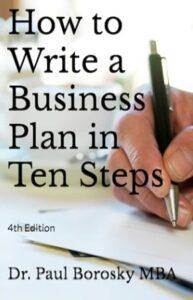The Critical Role of a Trucking Company Business Plan Template: A Roadmap to Success
By Dr. Paul Borosky, MBA – Business Plan Writer & Business Consultant
A trucking company business plan template gives new and growing carriers a proven framework to build a profitable, compliant, and lender-ready transportation business. It helps trucking entrepreneurs plan cash flow, forecast volatile expenses, calculate rate-per-mile profitability, stay compliant with FMCSA/DOT requirements, and avoid the operational pitfalls that shut down thousands of trucking companies each year.
Why a Trucking Company Business Plan Template Matters
The trucking industry is brutal. Fuel prices spike without warning, insurance premiums rise every renewal cycle, brokers delay payments, and maintenance drains cash flow fast. One bad quarter can force an owner-operator to park a truck for good.
Trying to launch or grow a trucking company without a solid plan isn’t just risky—it’s reckless.
A trucking company business plan template gives you a real roadmap. It provides structure, lender-required sections, trucking-specific cost models, and a clear way to plan operations, compliance, and revenue strategies without guessing.
This is the difference between a trucking business that lasts—and one that collapses under unpredictable margins.
Need Help Writing a Business Plan?
Call or Text Dr. Paul
321-948-9588
Email: Paulb@QualityBusinessPlan.com
What a Trucking Company Business Plan Template Includes
A professionally built trucking company business plan template should provide a complete structure for launching and growing a transportation business. It includes an executive summary outlining services, operating areas, competitive advantages, and funding needs, along with a detailed company description covering ownership, LLC structure, mission, and vision. The template analyzes industry trends—such as freight demand, RPM pricing, and competitive pressures—and defines target markets ranging from warehouses to 3PLs. It details services offered, marketing strategies, operations, safety compliance, and maintenance cycles. It also highlights management qualifications and includes financial projections covering startup costs, RPM assumptions, break-even miles, and cash-flow forecasts—ensuring full lender-ready credibility (NetSuite).
Why Generic Plan Templates Fail in Trucking
Generic templates never address trucking’s unique business model. They typically ignore:
-
RPM-based revenue
-
Fuel volatility
-
Insurance increases
-
Tire and repair cycles
-
Factoring charges
-
Broker payment delays
-
Compliance and safety requirements
-
Maintenance frequency based on mileage
A trucking company must anticipate:
-
Fuel = 25–40% of operating costs
-
Insurance increases = 10–25% annually
-
Maintenance = every 15,000–20,000 miles
-
Cash delays = 30–60 days on broker loads
If your plan doesn’t reflect these realities, lenders will reject it—and operations will collapse under real-world pressure.
Mini Case Study
In a published roll-up deal, a logistics operator used a detailed business plan and SBA-backed financing to acquire a freight and trucking company. Working with Yaw Capital, they structured a $4.7M package combining SBA funds and a seller note, closing in just 68 days despite volatile industry conditions. Yaw Capital
How a Trucking Company Business Plan Template Helps Prevent Failure
A trucking company business plan template helps prevent failure by forcing owners to confront the financial realities that shut down most new carriers. Many startups collapse because they underestimate fuel spikes, repairs, insurance, cash-flow delays, and working-capital needs (HBR). A trucking-specific template guides you through calculating true RPM profit, break-even miles, fuel budgets, maintenance cycles, required cash reserves, and total working capital. This isn’t paperwork—it’s survival planning that protects your business from the industry’s razor-thin margins.
Comparison: DIY vs Generic Template vs Trucking-Specific Template
| Feature | DIY Plan | Generic Template | Trucking Template (Yours) |
|---|---|---|---|
| Trucking terminology | No | No | Yes |
| RPM + fuel modeling | No | No | Yes |
| DOT/FMCSA compliance | No | No | Yes |
| Startup cost accuracy | Weak | Generic | Strong |
| SBA/bank-ready | Rarely | Sometimes | Yes |
| Industry-specific examples | None | Basic | Strong |
| Time to complete | 20–30 hrs | 10–15 hrs | 3–5 hrs |
This is exactly why most trucking entrepreneurs prefer a trucking-specific plan.
How Lenders Use Your Business Plan
Banks and SBA lenders closely evaluate a trucking company’s financial and operational readiness before approving funding (Freight Waves). They look at RPM-based revenue projections, startup truck and equipment costs, insurance requirements, working-capital needs, and detailed cash-flow forecasts. Lenders also assess the owner’s experience, safety and compliance programs, break-even miles, profitability timeline, and overall business structure. A trucking-specific business plan ensures every one of these requirements is clearly addressed, making your application lender-ready and credible.
How to Use a Trucking Company Business Plan Template (Step-by-Step)
-
Download the template
-
Add business name, logo, and contact info
-
Enter your company details
-
Select trucking services
-
Insert realistic RPM and weekly miles
-
Complete your cash-flow and financial model
-
Build your marketing and operations plan
-
Review and finalize for lenders
Total time: 3–5 hours, instead of 20+.
FAQs
What is a trucking company business plan template?
A professionally structured document tailored to trucking operations, compliance, costs, and lender requirements.
Do I need a business plan to get a trucking loan?
Yes. Lenders require financial projections, RPM analysis, and an operational strategy before approving financing.
How much does it cost to start a trucking company?
Between $75,000 and $250,000, depending on truck type, insurance, permits, and working capital.
How do owner-operators calculate rate-per-mile?
Total revenue ÷ total miles. The template includes standard RPM models.
What projections do lenders expect?
Fuel, repairs, insurance, RPM revenue, cash flow, startup costs, and break-even miles.
Conclusion: Your Roadmap to a Profitable Trucking Company
A trucking company business plan template isn’t optional—it’s the foundation of a financially stable, operationally sound trucking business. With the right structure and realistic projections, you can avoid costly mistakes, maintain profitability, and build a business that lasts.
If you want the fastest and most reliable path forward, start with a professional trucking template built specifically for this industry.
Download the Trucking Company Business Plan Template
Get a complete, SBA-ready trucking company business plan template designed for owner-operators and growing fleets.
Need a Custom Business Plan Written for You?
Call or Text Dr. Paul directly:
321-948-9588
PaulB@QualityBusinessPlan.com
About the Author: Dr. Paul Borosky, DBA, MBA

Dr. Paul Borosky, MBA and DBA is the founder of Quality Business Plan, creator of Dr. Paul's Organize-Plan-Grow Strategy, author of numerous published books on Amazon, and publisher of over 1,000 business focused videos on YouTube. For over 14 years, he has helped entrepreneurs and small business owners turn business concepts and dreams into tangible businesses Most recently, Dr. Paul has expanded his expertise into AI Business Integration, developing industry-leading strategies that use custom created and trained AI agents.


